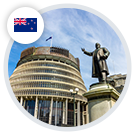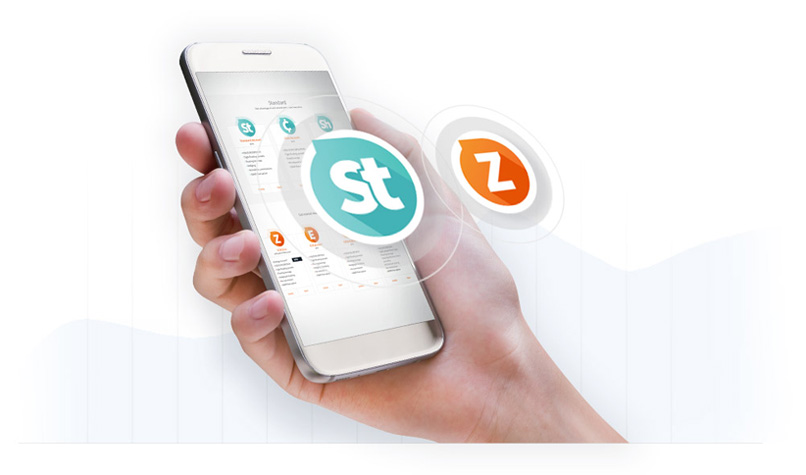CFDs are complex instruments and come with a high risk of losing money rapidly due to leverage. 73% of retail investor accounts lose money when trading CFDs with this provider. You should consider whether you understand how CFDs work and whether you can afford to take the high risk of losing your money.
The Foreign Exchange Market
The world’s largest market
Trading Foreign Exchange:
The foreign exchange market allows two currencies to be exchanged, at an exchange rate which is floating or fixed. This allows businesses from around the world to complete transactions across currencies. Currencies need to be exchanged to import produce from different countries, for example: a wine merchant in England exchanges their pound sterling (GBP) for euros (EUR) in order to purchase wine from France. Exchanging currencies is the basis for all international trades. Unlike the stock market, the forex market is decentralised – this means that there is no central trading area. Most foreign exchange transactions are executed over-the-counter (OTC) by banks, on behalf of their clients.
Where did it start?
It all began with the gold standard monetary system back in 1875. Before our current system was born, gold and silver were exchanged for goods and services. The problem was that gold’s value changed depending on the supply – if a new source was discovered, gold would become less valuable. Eventually, different countries began to peg an amount of their currency to an ounce of gold. The difference between these amounts was an exchange rate. After World War One this system broke down, and several years later currencies were no longer pegged to gold.
FX trading used to be completed exclusively through banks and forex brokers. However, as technology has developed, FX trading has become far more accessible. Individual traders can now access the FX market from their smartphones, and complete trades on the go.
Today, the forex market is open 24 hours a day, 5 days a week. The first markets open on Monday morning in Wellington, New Zealand, and the last close at 5pm (ET) on Friday in New York.
Currency Trading
How does currency trading actually work?
What is Currency Trading?
Currency trading, also known as FX trading, is the exchange of currencies between two parties at an agreed price. The trading parties may be financial institutions, multi-national corporations, banks, central banks, hedge funds, money changers, insurance companies, speculators, or individual traders.
Currency trading is done in pairs. A currency pair consists of a base and a quote currency – for example, the currency pair of EUR/USD consists of EUR, which represents the base currency, and USD which represents the quote currency. The exchange rate of EUR/USD at 1.1630 simply means that to own one euro, you need the equivalent of 1.1630 in US dollars.
The ultimate goal of FX trading is to identify the correct direction of the markets. It’s all about buying a financial instrument low and closing the position higher, or selling a financial instrument high and closing the position lower.
To begin, traders choose a trading platform to trade currencies on. There are many different trading platforms to choose from, including MetaTrader
The user-friendliness of trading platforms and the 24-hours/five-days-a-week trading schedule makes currency trading highly appealing. The markets’ high liquidity means traders can trade almost any volume at their desired price, and are not likely to experience price manipulation.
If that wasn’t enough, a daily turnover of about $5 trillion, the availability of leverage, and educational resources provided by some brokers attract a huge number of traders across the world.
There are many different strategies which are commonly used among traders:
Discover more on our Forex Trading Strategies page.
Forex Trading Hours
FX Market Centres Time Zones in Local and UTC Time
Oceania - Asian Forex Session
Wellington
New Zeland
NZD
FX Trading Hours
08:00-17:00UTC +12(+13)
Oceania - Asian Forex Session
Sydney
Australia
AUD
FX Trading Hours
08:00-17:00UTC +10(+11)
Oceania - Asian Forex Session
Tokyo
Japan
JPY
FX Trading Hours
08:00-17:00UTC +9
Oceania - Asian Forex Session
Hong Kong
Hong Kong
HKD
FX Trading Hours
9:30 - 16:00UTC +8
Oceania - Asian Forex Session
Shanghai
China
CNY
FX Trading Hours
09:00-17:00UTC +8
Oceania - Asian Forex Session
Singapore
Singapore
SGD
FX Trading Hours
09:00-17:00UTC +8
Oceania - Asian Forex Session
Mumbai
India
INR
FX Trading Hours
09:00-17:00UTC +5:30
Oceania - Asian Forex Session
Moscow
Russia
RUB
FX Trading Hours
09:30-19:00UTC +3
Oceania - Asian Forex Session
European Forex Session
Frankfurt
Germany
EUR
FX Trading Hours
07:00-15:00UTC +1(+2)
European Forex Session
Zurich
Switzerland
CHF
FX Trading Hours
09:00-17:30UTC +1(+2)
European Forex Session
Paris
France
EUR
FX Trading Hours
09:00-17:30UTC +1(+2)
European Forex Session
London
United Kingdom
GBP
FX Trading Hours
08:00-16:00UTC (+1)
European Forex Session
North America Forex Session
New York
United States
USD
FX Trading Hours
08:00-17:00UTC -5(-4)
North American Forex Session
Chicago
United States
USD
FX Trading Hours
08:00-16:00UTC -6(-5)
North American Forex Session
Toronto
Canada
CAD
FX Trading Hours
08:00-17:00UTC -5(-4)
North American Forex Session
What is a Currency Pair?
Example: EUR/USD
EUR = The first currency in the pair is known as the Base Currency
USD = The second currency in the pair is known as the Counter Currency or the Quote Currency
All major currency pairs contain the US Dollar and are the most commonly traded FX pairs.
EUR/USDEuro/US Dollar
USD/JPYUS Dollar/Japanese yen
GBP/USDBritish pound/US Dollar
USD/CHFUS Dollar/Swiss franc
USD/CADUS Dollar/Canadian Dollar
AUD/USDAustralian Dollar/US Dollar
NZD/USDNew Zealand Dollar/US Dollar
Crosses are pairs that do not include the USD otherwise known as FX "crosses".
AUD/CHFAustralian Dollar / Swiss Franc
AUD/JPYAustralian Dollar / Japanese Yen
CAD/CHFCanadian Dollar / Swiss Franc
CAD/JPYCanadian Dollar/ Swiss Franc
CHF/JPYSwiss Franc / Japanese Yen
EUR/AUDAustralian Dollar
EUR/CADEuro / Canadian Dollar
EUR/NZDEuro / New Zealand Dollar
GBP/AUDPound sterling / Australian Dollar
GBP/CADPound sterling / Canadian Dollar
GBP/CHFPound sterling / Swiss Franc
GBP/NZDPound sterling / New Zealand Dollar
NZD/CHFNew Zealand Dollar / Swiss Franc
NZD/JPYJapanese Yen / Japanese Yen
Currencies from emerging and developing economies, paired with a major currency.
EUR/TRYEuro/Turkish Lira
USD/TRYUS Dollar/Turkish Lira
USD/SEKUS Dollar/Swedish Krona
USD/NOKUS Dollar/Norwegian Krone
USD/DKKUS Dollar/Danish Krone
USD/ZARUS Dollar/South African Rand
USD/HKDUS Dollar/Hong Kong Dollar
USD/SGDUS Dollar/Singapore Dollar
USD/THBUS Dollar/Thailand Baht
USD/MXNUS Dollar/Mexican Peso
Trading Currencies
The Most Traded Currencies

Euro
EuropeThe EUR is the official currency of the Eurozone.
It is the second most traded currency in the FX market, beaten only by the US dollar. It is also the second largest reserve currency in the world.
Symbol: €
Code: EUR
Commonly traded with:
USD | GBP | JPY

United States dollar
United States of AmericaThe USD is the official currency of the United States of America.
Seven countries use the US dollar as their official currency. Aside from the US, it is the currency of two British Oversees Territories in the Caribbean.
Symbol: $
Code: USD
Commonly traded with:
EUR | GBP | JPY

Japanese Yen
JapanThe JPY is the official currency of Japan.
The yen is the third most traded currency in the foreign exchange market, and is frequently used as a reserve currency alongside the pound sterling, the US dollar and the euro.
Symbol: ¥
Code: JPY
Commonly traded with:
USD | GBP | EUR

Pound sterling
United KingdomThe GBP is the official currency of the United Kingdom.
The pound is the official currency of the UK as well as Jersey, Guernsey, Isle of Man, South Georgia and the South Sandwich Islands, British Antarctic Territory and Tristan da Cunha.
Symbol: £
Code: GBP
Commonly traded with:
USD | GBP | JPY

Australian Dollar
AustraliaThe AUD is the official currency of Australia.
The Commonwealth of Australia uses the Australian Dollar as its official currency. It is popular with currency traders because of the comparatively high interest rates.
Symbol: $
Code: AUD
Commonly traded with:
USD | NZD | GBP | EUR

Canadian Dollar
CanadaThe CAD is the official currency of Canada.
The Canadian Dollar is the fifth most held reserve currency in the world, and is usually popular with central banks due to the country’s general stability.
Symbol: $
Code: CAD
Commonly traded with:
USD | EUR | AUD

Swiss Franc
SwitzerlandThe CHF is the official currency of Switzerland and Liechtenstein.
The Swiss Franc is also used by the Italian exclave Campione d’Italia. The currency’s coins are inscribed in Latin to account for the different languages used in Switzerland.
Symbol: Fr., CHf, SFr
Code: CHF
Commonly traded with:
USD | EUR | GBP

Renminbi
ChinaThe CNH or RMB, is the official currency of People’s Republic of China.
Yuan is the base unit of RMB. The trading of CNH or RMB is done in the offshore (outside China) markets while CNY is traded onshore (within China).
Symbol: ¥
Code: CNY
Commonly traded with:
HKD | INR | JPY | USD

Swedish Krona
SwedenThe SEK is the official currency of Sweden.
The Krona has been the official currency of Sweden since 1873, and is often referred to as the Swedish crown as krona means crown in Swedish.
Symbol: kr
Code: SEK
Commonly traded with:
USD | EUR

Hong Kong Dollar
Hong KongThe HKD is the official currency of Hong Kong.
The Hong Kong Dollar is the thirteenth most traded currency on the foreign exchange markets. The currency is also used in Macau alongside the Macau pataca (MOP).
Symbol: HK$
Code: HKD
Commonly traded with:
USD | CNH | EUR | GBP

New Zealand Dollar
New ZealandThe NZD is the official currency of New Zealand.
This currency was introduced as late as 1967, and has a total of ten denominations altogether. The currency has consistently made it in to the top 10 most traded currencies.
Symbol: $
Code: NZD
Commonly traded with:
USD | AUD | GBP | EUR

Singapore Dollar
SingaporeThe SGD is the official currency of Singapore.
The Singapore Dollar is also accepted in Brunei, just as the Brunei dollar is customarily accepted in Singapore. It is the twelfth most traded currency in the world.
Symbol: S$, $
Code: SGD
Commonly traded with:
USD | CNH | EUR
Forex Trading Q&A
Popular questions answered
Who is a Forex Trader?

An FX trader is any individual who exchanges one currency for another. Individual traders commonly use different platforms to exchange foreign currency. These include banks, financial institutions, money changers, or FX brokers. Most trades are completed over-the-counter, which means that the trade is facilitated via a bank rather than a centralised entity.
What is a Forex Pip?

PIP is the abbreviation of “point in price” or percentage in point” and it is the smallest unit of price movement in the foreign exchange market. For example, when the exchange rate of EUR/USD moves to 1.1552 from 1.1550, the currency pair has risen by 2 pips (or 0.0002).
What is Forex Scalping?

Forex scalping is a trading strategy which aims to benefit from small price movements in the market. Scalp traders will target intraday price movements and only hold positions for a small amount of time to take advantage of small market opportunities. Forex scalpers must be prepared to monitor the markets all day long.
What is Forex Leverage?

Forex leverage is offered by brokers to enable traders to maximize their trading potential. The forex market offers higher leverage than other markets, and this attracts potential traders. Leverage allows traders to deposit small amounts and trade with high volumes. The term ultimately means borrowing money in order to increase the potential returns on a trade, but this means losses get increased too.
What is a Forex Spread?

The difference between the ask price and bid price is known as the spread. The spread represents the cost of a transaction; the lower the spread, the lower the cost. A spread is influenced by a number of factors: the supply of the asset, the stock’s trading activity, and the total demand or interest in a particular asset.
What is Forex Hedging?

Hedging is a technique designed to reduce the risk caused by adverse price fluctuations. Investors and traders might implement a forex hedge in order to protect their position from risk as exchange rates change. Foreign currency options are a common hedging method, and grant the trader the possibility to buy or sell at a future exchange rate.
What is a Forex Swap?

A swap is simply an exchange of one currency for another. At a later date, the two parties who made the swap will receive their original currency back with a forward rate. The forward rate locks in a specific exchange rate and therefore acts as a kind of hedge. The swap varies significantly among different financial instruments.
What is a Forex Drawdown?

A drawdown is the difference between a relative peak and a relative trough in the value of an investment. After a new high is reached, drawdowns track the percentage change between the previous high and the smallest trough. In this way, drawdowns are useful for determining the financial risk of a certain asset.
What is Forex Slippage?

Slippage refers to the difference between the requested price of a trade and the price at which it is eventually executed. Slippage is usually found when the markets are particularly volatile, and prices have moved quickly during the time it takes for the trade to be ordered and completed. Slippage can have positive and negative consequences.
Forex Trading Fundamentals
Understanding Trading Fundamentals
What are Forex Reserves?
Forex reserves are foreign currencies held by a central bank in order to grant greater flexibility and resilience.
A reserve is any currency held by a financial authority which is centralised. The reserve assets can be used to endure market shocks if a particular currency becomes devalued or suddenly crashes. Higher foreign currency reserves ultimately mean lower risks associated with exchange rate fluctuations.
Forex reserves are usually held in US dollars, British pound sterling, euros, Chinese yuan or Japanese yen. This is due to these currencies being the most common on the foreign exchange market.
What are Forex Signals?
Forex signals are trade forecasts usually issued by knowledgeable and experienced signal providers.
The signals are based upon a series of technical analyses or news events, and are used by traders to help them decide whether they should buy or sell a currency pair. Day traders in particular may use a variety of forex signals to inform their next trade. Forex signal systems produce either manual or automated signals.
In a manual system, the trader actively looks for signals and interprets them to choose whether to buy or sell. In an automated system, the software identifies a signal and makes the programmed response.
What is Foreign Exchange?
Foreign exchange is the market where one currency is exchanged for another. It is always done in pairs; for example if a trader wants to buy Euro and sell the US Dollar, then he would be trading the EUR/USD currency pair.
Similarly if a trader wants to sell the US Dollar and buy the Japanese Yen he would be trading the USD/JPY pair. The price of a currency pair is called the exchange rate. It is determined by political, economic and environmental factors.
Transactions in foreign exchange are usually conducted in high volumes. Foreign exchange market has no physical location and hence it is called a decentralised market. It is open 24 hours a day, 5 days a week and is the largest market in the world.
Forex Fundamental Analysis
What is Forex Fundamental Analysis?

Macroeconomic Indicators

These are fundamental indicators which directly or indirectly point towards a weak or strong economy.
Macroeconomic indicators based on the Gross National Product (GNP) and the Gross Domestic Product (GDP) are used to estimate an economy’s efficiency.
This data is then released in reports which have major effects on a country’s currency. Aside from GNP and GDP, some of the major macroeconomics are:
- Unemployment rate
- Bankruptcies
- Retail sales
- Consumer leverage ratio

Geopolitical Events

These types of events have direct or indirect consequences, either worldwide or for a particular set of countries.
Geopolitical events have great psychological and emotional consequences for the equity and currency markets.
A few examples of such events including:
- Trade wars between major countries or economies which arise due to rising tensions among nuclear-armed, powerful countries.
- Major decisions taken by OPEC (Organization of Petroleum Exporting Countries), which have direct effects on oil prices.
- Major events like Brexit, which trigger volatility into worldwide stocks and currency markets.

Gross Domestic Product and Inflation

Gross domestic product (GDP) is a financial economic indicator which measures the total value of goods and services produced in a country, over a designated period of time.
The GDP is one of the most important indicators, and is used to evaluate a nation’s overall economic health. Construction costs, government outlays and investments all contribute to a country’s overall GDP. Inflation is an economic indicator that measures the increase of a country’s prices for major goods and services.
The rate at which prices are rising dictates the rate at which the purchasing power of the currency is falling. In order to maintain a smooth economy, central banks aim to limit inflation and avoid deflation.
Forex Trading Signals
Who are Forex Signal Providers?
A forex signal is a suggested entry or exit point for a forex trade, usually with a specific price and time indicated. Forex signals can be obtained from either specialist companies or a number of knowledgeable and experienced traders. The services may be free or come with a charge – most brokers offer their own forex signals either for free or for a low price.
Traders can view the performance results for any signal provider on a platform, and decide to accept or reject future trade recommendations into their trading accounts. Due to providers protecting their strategies, traders may have to blindly follow a signal provider.
Some brokers offer their own unique twists on forex signals, by merging the concept of forex signals with a number of technical tools into one grand forex trading system. FXTM Trading Signals is one such example.
FXTM Trading Signals
FXTM Trading Signals provides traders a unique opportunity to use a tool for spotting trading opportunities in the market.
Features of FXTM Trading Signals include:
- Developed for 14 Financial Instruments
- Provides additional outlook on price movements with 3 popular forex indicators
- Showcases 2 trading scenarios: the most probable & an alternate
- Updates twice daily, before the opening and closing of the European and US trading sessions.
To learn more about FXTM Trading Signals, click here.
Demo Trading vs. Live Trading
Demo Trading Accounts and Live Trading Accounts
Demo Trading Accounts
Demo trading accounts are perfect for traders looking to establish the fundamentals and work on their technique. Beginning on a live account means that there’s the possibility of losing real money as you work out which technique works best for you.
Before moving on to a live trading account, it is a good idea to try out a few different approaches, and practice with a demo account. Demo accounts grant traders the opportunity to develop and test their trading skills, without facing the kind of risks you do on a live account.
Traders who want to iron out the creases in their trade before they hit the live markets have a range of demo accounts to choose from.
Live Trading Accounts
After you’ve refined your skills and experimented with different types of analysis and indicators on a demo account, it is time to switch to a Live Account and start trading with real money! Demo Accounts are great for practice, but Live Accounts offer all the real advantages of the FX markets.
Once traders are ready to move on to the live markets, having established a trading strategy which works for them, they can set up their first Live Account. Like Demo Accounts, there’s a huge range of options available for a trader looking to upgrade their trading from Demo to Live.

Advantage
Account

Advantage Plus
Account

FXTM Pro
Account
CFDs are complex instruments and come with a high risk of losing money rapidly due to leverage. 73% of retail investor accounts lose money when trading CFDs with this provider. You should consider whether you understand how CFDs work and whether you can afford to take the high risk of losing your money.
Forex Trading Tools and Software
Free online trading tools and software every trader should use
FX Trading Tools
Different types of trading tools for technical analysis:
When it comes to finding the right tool for daily analysis, a trader has a wide range of technical analysis tools to choose from.
Popular indicators include: the moving average indicator, which filters out price fluctuations to help traders identify trend directions, and Bollinger Bands, which plot two lines, two standard deviations away from the moving average.
Oscillators based on statistical concepts are another common addition to the trader’s toolkit. Oscillators are used to estimate whether an asset is overbought or oversold. Popular oscillators include the RSI (Relative Strength Index), MACD (Moving Average Convergence/Divergence), Momentum, Stochastic and ADX (Average Directional Movement Index).
To identify turning points in the markets, and analyse chart patterns, FX traders commonly use support and resistance, along with Fibonacci retracement tools and Japanese Candlestick patterns.
Aside from these, other FX traders prefer to use chart patterns including head-and-shoulder, double top/double bottoms, and draw trend lines to identify trend patterns.
Forex Trading Software:
There are many FX trading platforms that a trader may choose from. Some of them have a monthly subscription, but most are available for free. Some popular forex trading platform providers include Zulutrader, Ninjatrader and TradingStation.
Some of the most popular forex trading platforms are:
MetaTrader 4
MetaTrader 5
More Insights into Forex Trading

Forex Videos

Learn about key forex terms, basic trading terminology, technical analysis concepts, the importance of discipline, risk management and much more by watching our educational videos.
At FXTM, we do everything possible to give you and everyone who trades with us access to great Forex trading educational resources for beginner and advanced traders.
Forex Education VideosLearn key forex trading and technical analysis concepts with our short and easy-to-understand educational videos.
Short Forex Trading Videos
Forex Glossary

No Forex Education is complete without the help of a good glossary. That’s why we’ve compiled our complete glossary of forex terms to help you navigate through the countless terms you’ll encounter in the forex industry.
Our glossary keeps things simple and covers a range of key forex terminology. Take on the forex markets equipped with all the technical vocabulary you need!
Forex GlossaryOur Periodic Table of Investment is a handy table which showcases some of the most important investment terms, divided into simple categories for ease of use.
Periodic Table of Investment
Forex Education

We believe the best trader is an educated one. That’s why we offer traders the chance to expand their knowledge of FX trading with FXTM’s educational articles.
Forex Educational ArticlesWritten by our Head of Education, this series guides traders through an eclectic range of topics – from bitcoin mining to bearish and bullish trend reversals.
Our articles are designed to give both novices and advanced traders relevant insights into the fundamentals of forex. Struggling to understand a particular forex topic, or simply want to discover more? Explore more with our guide and Forex Trading Strategies
CFDs are complex instruments and come with a high risk of losing money rapidly due to leverage. 70% of retail investor accounts lose money when trading CFDs with this provider. You should consider whether you understand how CFDs work and whether you can afford to take the high risk of losing your money.
Scroll to Top













